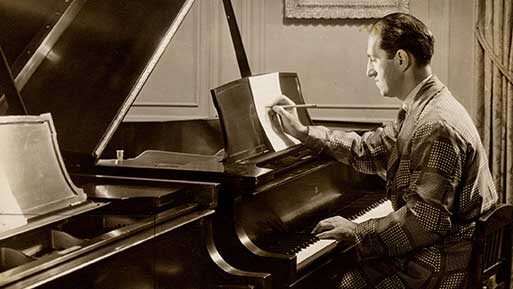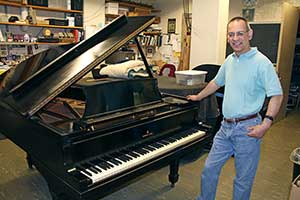http://youtu.be/0WES6nTljTU
Ghost in the machine
A fully restored 1933 Model A Steinway piano, once owned and played by George Gershwin, now calls the U-M School of Music, Theatre & Dance its permanent home.
Marc Gershwin, George Gershwin’s nephew, donated the piano to the school in 2013 as a crowning gesture of partnership between the Gershwin families and the University during the creation of the U-M Gershwin Initiative.
Announced last year, the initiative provides U-M with complete access to the Gershwin archives to develop the George and Ira Gershwin Critical Edition — the only scholarly edition of the Gershwins’ music — as well as student performances, new courses, and scholarly symposia of national reach and impact.
“As plans for the U-M Gershwin Initiative evolved, I realized the University of Michigan would be the ideal home for my uncle’s Steinway,” Marc Gershwin said. “I wanted the instrument to be accessible to the students and faculty who would be preserving the legacy of George and Ira Gershwin’s music through this important initiative.“I’m delighted that the piano will once again be in regular use, and am thrilled that it has been restored to performance condition.”
“The opportunity to perform on George Gershwin’s piano will be extraordinarily inspirational for our students and faculty,” said Christopher Kendall, dean of SMTD. “We are so grateful to Marc for his generosity and to the entire Gershwin family for their vision and commitment to ensuring that the music of their remarkable forbears will be preserved through the U-M Gershwin Initiative.”
Heart and soul
After George Gershwin’s untimely death in 1937, the U-M Gershwin piano resided in the New York City apartment of George’s mother, Rose Gershwin. Following her death in 1948, Marc Gershwin’s parents, Arthur and Judy, occupied the apartment. Almost never played during this period, the piano did not move from the apartment until it was brought to Ann Arbor in the spring of 2013.
The U-M instrument is one of three Gershwin pianos in the United States. The others are housed in the U.S. Library of Congress in Washington, D.C., and the Songwriter’s Hall of Fame in New York.
Steinway’s records indicate that George Gershwin took delivery of the piano in January 1934 while preparing for the 10th anniversary tour of “Rhapsody in Blue.” It is presumed he used the instrument to produce portions of “Porgy and Bess,” first performed in 1935.
Careful rehabilitation
In partnership with Patrick DeBeliso, proprietor and master artisan-craftsman of PianoCrafters Inc. of Plymouth, Mich., the Gershwin piano has undergone several hundred hours of careful rehabilitation to restore it to playable condition.

George Gershwin at the piano recently donated to the University of Michigan. (Image courtesy of the Library of Congress.)
The instrument received a new soundboard — handcrafted to duplicate the original, which suffered from both age-related deterioration and an irreparable crack — strings, keyboard, hammer, and damper actions. The exterior of the piano was not refinished, although the case was cleaned to remove decades of dirt and grime.
“It will retain the look of a piano that was used by a great composer,” said Robert Grijalva, director and assistant professor of piano technology, who oversaw the restoration project. “[It’s] a bit worn around the edges, but otherwise presentable.”
Grijalva and DeBeliso documented the yearlong restoration process, and the challenges faced by the technicians, in a blog on the U-M Gershwin Initiative website.
The piano’s original keyboard and action are being preserved for public viewing at the E.V. Moore Building, SMTD’s main facility for music studies. The building is undergoing an extensive renovation and expansion, scheduled for completion in fall 2015, and the piano’s permanent home will be in the new addition, the William K. and Delores S. Brehm Pavilion.
The Gershwin piano is the fourth historic piano to undergo a major renovation at U-M and reside on campus. The others are:
• The Elizabeth Gould Hochmann Steinway Model B, on permanent loan to the U-M Museum of Art, featuring a case design that is a copy of the first Steinway piano ever built.
• The Martha Cook Steinway Model A, built in 1913, in the Martha Cook residence hall.
• The Brescoll Steinway Model C, built in 1880, in the President’s House. The oldest Steinway on campus, it formerly was owned by the manager of Carnegie Hall in New York City.
(Top image courtesy of the Ira Gershwin Archive.)




Craig Wolson - 1971 (LSA), 1974 (Law)
As an amateur pianist and lover of Gershwin music, I find this donation to be very exciting. I hope that it will bring Michigan and its School of Music the recognition that they deserve and often don’t receive.
Reply
HDavid Kaplan - 1956
As a reporter and Senior Editor of The Michigan Daily, I cannot let a typo go uncorrected. Gershwin died in 1937, not 1938 as stated in the article.
Reply
Deborah Holdship
MT regrets the error. It has since been corrected. (Ed.)
Reply